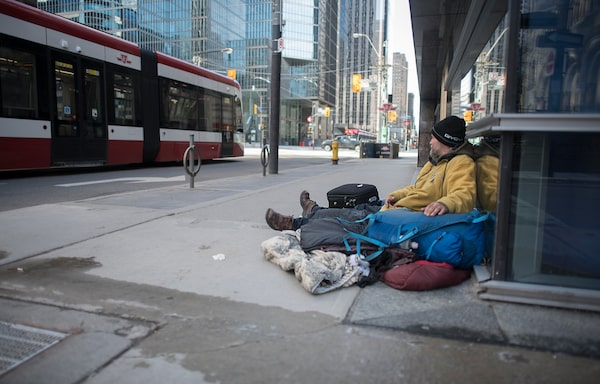
William, 51, is photographed by the space where sleeps on King St. West, in downtown Toronto. He says there's limited places for people without homes to stay.Fred Lum/The Globe and Mail
Toronto officials said Tuesday that 30 homeless people have tested positive for the novel coronavirus, and that public health is actively investigating cases at three shelters, including one for refugees where at least 11 people have contracted the disease.
Eileen de Villa, the city’s Medical Officer of Health, said many of the 30 people had recovered in the cases that were spread across seven shelters. But her staff are still tracing the contacts of positive cases at the Willowdale Welcome Centre for refugees in North York; at a 24-hour “respite” shelter site on the east side of the city’s downtown, and at Seaton House, one of the city’s oldest shelters for homeless men.
Just a week ago, the city said it had only six confirmed cases of COVID-19 among the homeless. Dr. de Villa warned on Tuesday that homeless people often suffer from other health conditions and are particularly vulnerable to COVID-19, meaning deaths “may be an unfortunate eventuality.”
She made the comments as the city unveiled plans for a 400-bed “recovery centre” for homeless people who test positive. The site will be run by local health care providers who have experience with the homeless, with help from international aid group Médecins sans frontières (Doctors Without Borders). A smaller interim site opened Tuesday.
Mary-Anne Bédard, the head of Toronto’s shelter department, said that in recent weeks, the city has moved 1,000 homeless people out of crowded shelters and into hotel rooms, new emergency shelters and a small number of public housing units. And she said Tuesday that the city was on schedule to move another 1,000 by April 30, as it tries to improve physical distancing for those who remain in shelters. It has also opened isolation centres for homeless people awaiting test results.
Some homelessness activists have criticized the city’s response as too slow, with the pandemic stalking a vulnerable population crammed into shelters that have been packed for years.
Ms. Bédard said identifying the most vulnerable homeless people and moving them out of shelters takes time: The city has had to sign contracts for cleaning, catering and security at its new leased hotels, complete fire and safety inspections and train 300 redeployed city staff. Plus, the homeless people involved must be treated with dignity, she said, and given a choice about their move.
Patricia Mueller, chief executive officer of the Homes First Society that operates the Willowdale shelter suffering from the city’s worst outbreak, as well as seven other shelters, said Tuesday that 16 of her staff have tested positive. Ms. Mueller also said 14 shelter residents had tested positive for the coronavirus, up from 11 on Monday. She would not confirm that the new positive tests among staff and residents were at the same shelter, citing privacy concerns.
Shelter workers across the city had been advised to don protective gear when a shelter resident displays or reports symptoms during mandatory health screening. At the Willowdale shelter, staff have been told to self-isolate at home and wear masks at work.
Ms. Bédard said the city was advocating for more protective gear for shelter workers from the province, but was following current provincial guidelines for its use. She said Toronto has provided $1-million worth of gear and cleaning supplies to community agencies that run many of the city’s shelters, as well as providing masks and other gear from the city’s limited stock. The city has also provided funding to give shelter workers raises, she said.
Toronto Fire Chief Matthew Pegg, who is heading the city’s emergency response to COVID-19, laid out detailed numbers Tuesday on how long the city has before its supplies of personal protective gear run out.
Under a worst-case scenario, with full outbreaks at all of the city’s long-term care homes and shelters and high demand for ambulance emergency calls, Chief Pegg said Toronto has about a month’s supply or less of N95 respirator masks, surgical masks and isolation gowns. Its supply of face shields would run out in just eight days.
But at the current pace, the city’s inventory would last longer: 107 days of N95 respirator masks, 52 days of surgical masks, 51 days of gowns and 26 days of face shields.
Chief Pegg said the city was working with the province to obtain more equipment, in the face of a global shortage.
Sign up for the Coronavirus Update newsletter to read the day’s essential coronavirus news, features and explainers written by Globe.